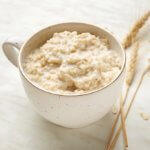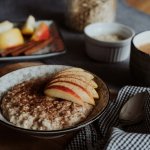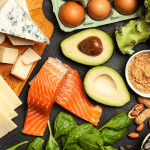All about the metabolism – how it works
February 2, 2022- Gesund leben
- Nutrition

The term metabolism often comes up in connection with dieting and losing weight, with a slow metabolism often cited as the cause of obesity. In fact, however, it is so much more than that, because it forms the foundation for all vital processes in the body. So without a metabolism, nothing works.
To understand why a slow metabolism affects weight loss and what you can do to boost it, you first need to know what metabolism is and how it works.
Everything you need to know about it, and what you can do about a slow metabolism, you will learn in this article. At the end, you’ll also find tips for a healthy breakfast and foods that will boost your metabolism.
Übersicht
What is metabolism?
Let’s start with the basics: Metabolism describes all the chemical processes that take place in our cells. In the process, different substances are converted into others in the body. In addition to producing energy and maintaining bodily functions, the metabolism’s task is to build up and break down or maintain bodily substances. This includes almost all cells that cavort in our body, including muscle and fat cells.
The whole process is divided into two different metabolic states, catabolism and anabolism, which will be explained in more detail in the next section.
How metabolism works
In order for our body to perform vital functions, it needs energy. We get this energy from our food and the nutrients it contains. It is then the job of the metabolism to break down the food into its individual building blocks and transport them to the cells. This means that protein, fat and carbohydrates are broken down into amino acids, fatty acids and glucose and transported via the blood to their destination. Once there, new substances are formed from them, such as muscles, nerves or bones.
Finally, the waste products that result from these processes are transported away from the cell and excreted again. Certain enzymes are involved in each of these steps. They do most of the work.
If more energy is taken in through food than can be broken down, energy reserves are stored in the body’s fat stores, resulting in obesity.
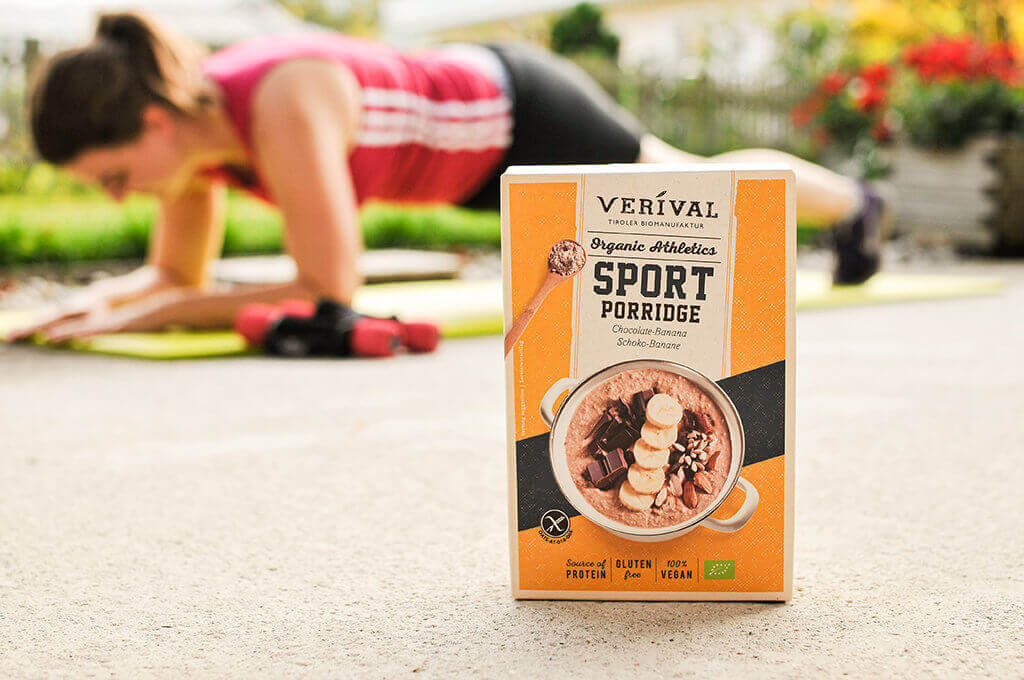
In common parlance, digestion is often mistakenly equated with metabolism. However, digestion only does the preliminary work, because the stomach and intestines break down food into its individual components. Only then can the smallest substances produced in the process be absorbed by the intestine and released into the blood. Finally, they reach the individual cells via the bloodstream, where they fulfil specific tasks.
What are anabolism and catabolism?
Metabolism is composed of anabolic and catabolic phases. In the catabolic phase, the body breaks down nutrients absorbed through food. This produces so-called ATP (adenosine triphosphate), which serves as fuel for our cells. In addition to the many other functions of ATP, it is needed, for example, to produce body heat or to move the muscles.
Anabolism then uses the released ATP to build up a wide variety of body substances. This is why we often speak of anabolic metabolism. This state is particularly interesting for strength athletes because muscles are also built up during anabolism. To promote muscle building, the body should be well supplied with protein and other important nutrients during this phase.
Anabolism and catabolism alternate and never run in parallel. Rather, they form a cycle that is regulated by enzymes.
What are the causes of a slow metabolism?
According to Dr. Chih-Hao Lee of Harvard University, the processes just described occur at different intensities in different people. Whether your metabolism is fast, slow or average depends primarily on your genes. Furthermore, age also has an influence on how fast your metabolism works. So as you get older, the processes become a little slower. (1)
How well the metabolism works is reflected in how easy or difficult it is for someone to gain or lose weight. Better said, with a slow metabolism, fewer calories are burned and excess energy is stored in the form of fat reserves.
However, it would be a fallacy to blame metabolism alone for obesity. Lifestyle, which includes exercise and a healthy diet, has a far greater influence. (1)

Those affected by a slow metabolism often not only have problems losing weight, but also freeze more often or suffer from concentration problems. That’s why those affected want to quickly rev up their slow metabolism and thus improve their quality of life. You can find out how this works in the following.
How can you boost a slow metabolism?
To a certain extent, it is indeed possible to give the metabolism a little boost. Namely, the two most important points to boost your metabolism are healthy eating and exercise.
We’ll look at what that means in detail in this section.
Fast movements for a fast metabolism
Exercise not only makes you sweat, but also your metabolism. Therefore, you should definitely integrate exercise into your daily routine if you want to give your metabolism a kick start.
If exercise is already an integral part of your daily routine, it’s worth incorporating interval training into your exercise habits. For example, combine your usual jogging routine with short sprints or try High Intensity Interval Training (HIIT). These short, intense workouts are easy to incorporate into your exercise routine and have a big impact. After a HIIT workout, your metabolism is really revved up for the rest of the day and burns calories for all they’re worth.
Training with weights for more muscles
Muscle mass requires more energy than fat mass, not only during exercise but also at rest. By building muscle, you can boost your metabolism and increase your daily calorie intake. You can easily find out how many calories you need to eat per day to maintain your weight with our calorie calculator. On the one hand, parameters such as age, gender, height and weight are used to calculate your daily calorie requirement. On the other hand, your activity level also plays an important role.
In order for your muscles to grow and your metabolism to benefit, you need to train them. Strength training is particularly good for this. In order to promote muscle growth, the training stimuli must become more and more intense over time. This happens, for example, by increasing the weights used. But exercise alone is not enough to boost your metabolism. The right diet also plays an important role.

Protein-rich diet
Your metabolism is always working at full speed when you eat, digest or store nutrients. This process is called the thermic effect. Basically, it describes how much energy your body needs to digest and use the food you eat. Depending on what you eat, this effect can be stronger or weaker.
While the thermic effect is only 0-3% for fat and 5-10% for carbohydrates, it is much higher for protein at 20-30%. (2) It therefore takes longer for the body to fully absorb protein than fat and carbohydrates. As long as this process is going on, energy is needed and thus calories are burned.
However, science has not yet been able to finally clarify how strong this effect actually is. However, the results of various studies speak for the combination of a high protein intake and strength training so that your metabolism works better.
In the next section, you’ll find out which foods can rev up a slow metabolism.
Foods that boost your metabolism and help you lose kilos
Protein as a metabolism booster
As we have already learned, protein-rich foods require more energy for the body to utilise them. Therefore, it is worth making them a fixed part of every meal.
The most important vegetable protein sources include pulses such as beans or lentils, nuts, seeds, fruit, vegetables and cereals or pseudo cereals such as millet, oats or quinoa. The following applies: The more different protein sources you combine, the better. The most important animal protein sources are meat, fish, eggs and dairy products.
To start the morning with a good load of protein, the VERIVAL sports breakfast, for example, is ideal. With its 100% vegetable protein power, it supplies your body with essential amino acids and boosts your metabolism.

Green tea – a tried and tested miracle weapon
Besides protein, green tea has also been proven to have a positive effect on the metabolism. It sometimes contains so-called epigallocatechin gallate – yes, a real tongue twister. It is known to stimulate fat burning and increase calorie consumption. According to a meta-analysis from 2011, just 250 grams of epigallocatechin gallate boosts the metabolism so much that the body burns about 100 kcal extra. This amount is equivalent to about three cups of tea. (1)
Berries – the all-round talents
Berries are not only bursting with vitamins, they also contain a considerable amount of antioxidants. These protect against free radicals, some of which are formed during metabolic processes and promote diseases such as cardiovascular disease, cancer or arteriosclerosis. To prevent the formation of harmful substances, berries should not be missing from your diet.
Stimulate your metabolism with a healthy breakfast
With the right breakfast every morning, you lay the foundation for a metabolism boost. Start the day with a healthy, protein-rich meal. Now you can find out what a healthy breakfast looks like:
Protein-rich cereals such as millet, quinoa or oats are a good basis for the morning energy kick. Take a portion of oat flakes, for example, and make a delicious muesli or cook them up into a warming porridge.
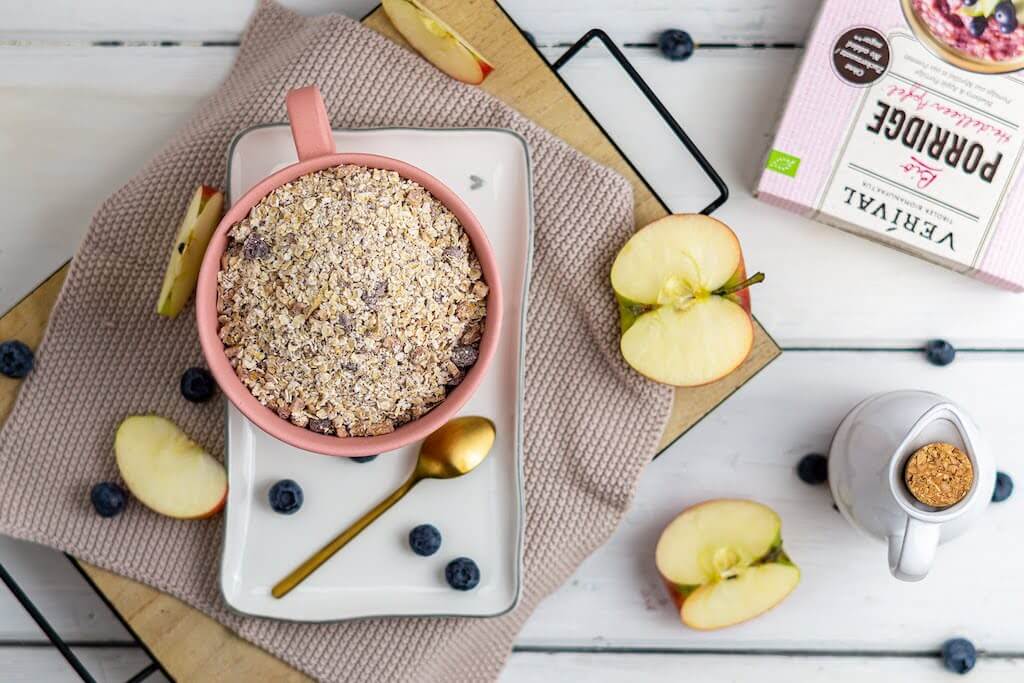
Milk as an animal protein source or the protein-rich, vegetable alternative from soy is suitable for porridge preparation. Muesli also tastes good with yoghurt or quark.
Basic recipe: Oatmeal
Ingredients
- 250 ml milk or a plant-based alternative
- 50 g oat flakes
- A pinch of salt
- 2 tbsp honey or agave syrup
- 1/2 tbsp cinnamon
Instructions
- Heat up the oat flakes with a pinch of salt and the sweetener of your choice (honey or agave syrup) in the milk or plant-based drink (do not forget to stir well).
- Let the porridge steep for 3 minutes.
- Put the porridge into a bowl and sprinkle it with cinnamon.
- Enjoy!
Nutrition
Serve with toppings such as nuts, nut puree or seeds and add fresh berries or dried fruit according to your taste. This not only adds variety, but also provides an extra portion of protein.
sources:
(1) Harvard Health Publishing (2021, 30. März). Die Wahrheit über den Stoffwechsel. Harvard Health Publishing. https://www.health.harvard.edu/staying-healthy/the-truth-about-metabolism
(2) Tappy L. Thermische Wirkung der Nahrung und Aktivität des sympathischen Nervensystems beim Menschen. Reprod Nutr Dev. 1996;36(4):391-7. doi: 10.1051/rnd:19960405. PMID: 8878356.

